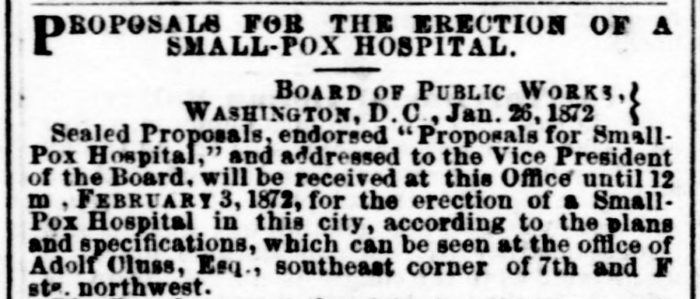 Smallpox is, thankfully, no longer an issue today. With two strains deep-frozen in freezers in Moscow and Atlanta, we do not have to worry about a disease that kills 30% of all afflicted any more. Even in 19th Century Washington, it was no longer the death-bringer it had been, as vaccines had been developed even before D.C. became the federal capital.
Smallpox is, thankfully, no longer an issue today. With two strains deep-frozen in freezers in Moscow and Atlanta, we do not have to worry about a disease that kills 30% of all afflicted any more. Even in 19th Century Washington, it was no longer the death-bringer it had been, as vaccines had been developed even before D.C. became the federal capital.
Nonetheless, cases of the dreaded disease did show up, and had to be dealt with. The obvious way was quarantine, and as early as 1854, a “Small-Pox Hospital” was created. In the year ending June 30, 1855, a total of eight people were admitted to the hospital, of which six survived.
In 1863, an article in the Daily National Republican described the hospital as a “small shanty, having two apartments” situated on “East Capitol Hill, in a low, malarious-breeding spot.” In the middle of the Civil War, however, no great efforts were made to improve this, and it was not until 1871, when the Board of Health determined that “both to its character and extent, the accommodations are entirely inadequate to the proper care and treatment of patients” that any attempt to remedy this was made.
Thus, in January 1872, money was appropriated “for the erection of a Small-Pox Hospital in this city.” An ad ran in the papers requesting proposals to build. It added that plans had been drawn up by Adolph Cluss, and could be viewed in his office.
By March of that year, James G. Naylor (pictured) was at work, and the March 2 Washington Evening Star wrote:
The new small-pox hospital is being rapidly built by Mr. Naylor, the contractor, and will be ready in about three weeks. It is a frame structure, and is located in the extreme northeastern section of the grounds, and will accommodate about 75 patients.
The “grounds” referenced were what we would call Reservation 13 today, located at the intersection of 19th and B (Independence) Streets SE.
A few months after the new building was completed, the Evening Star reported,
The old small-pox hospital was destroyed today by fire, under the direction of the health officer, Mr. Gatchell, who, as a precautionary measure against the spread of the fire, obtained the services of the Columbia engine to be on the ground.”
Sadly, others were not as cautious as Mr. Gatchell, with the Star reporting that a Mr. Ober, who was in charge of the ambulance tasked with bringing patients to the small-pox hospital, had taken his patients “up through Garrison Street and through the crowd of children just dismissed from the Wallach school building.

Detail of the request for proposals published in the Washington Evening Star of January 29, 1872. (LOC)
These possibly deadly mistakes caused the city, later that same year, to promulgate a series of “Rules and Regulations in Regard to Small-Pox.” Included within was admonition that “Parents and guardians shall cause their children and wards to be vaccinated before they attain the age of two years.”
In spite of these, patients kept coming to the hospital, and the following year the hospital took possession of a house to be used by its employees, and the hospital itself was expanded. This did not sit well with some of the neighbors, who complained that the hospital “endangered the lives of the men employed there, and requesting that the nuisance be removed.” There is some irony when you realize that “there” was the city jail.
When a smallpox epidemic swept through New York City and other cities up north in 1875, Washington itself was spared. Whether this was due to the hospital and the rules and regulations, or that simply fewer people with the disease arrived in D.C. in that time, can hardly be determined at this late date. The fear of a similar epidemic did, however, cause people to reconsider the current infrastructure, and it was determined that the “present building is entirely unfit for the purpose.”
It would take another 20 years for the city to act on this, however. More on that in future columns.
